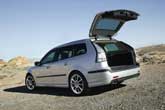Recent Articles
Popular Makes
Body Types
2006 Saab 9-3 SportCombi First Drive
Saab returns to its roots with the safe and speedy SportCombi
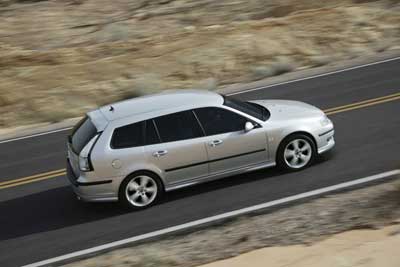
SAN DIEGO – Saab loyalists love hatchbacks. Chalk it up to the demographic’s desire to own a set of wheels that sets them off as individualists, free-thinkers, crack-pots – likely with tenure at a local university. A hatchback, especially one sold closer to the luxury end of the automotive spectrum, flies in the face of convention, and provides its owner the smug satisfaction of knowing that the choice is both a smack upside the head of conformist society and a useful, roomy, do-it-all kind of car. The tradition of Saab hatchbacks began with the 95 Wagon in 1959. Twenty-five years later, during the Swedish brand’s heyday in the mid-1980s, the Saab 900 Sedan was an anomaly in a lineup that consisted primarily of three- and five-door hatches equipped with normally-aspirated and turbocharged four-cylinder engines. Today, half of the 500,000 Saabs on American roads are hatchbacks. But when the Saab 9-3 was completely redesigned for the 2003 model year by its bumbling new owner General Motors, the hatchback body style – the thing that kept loyal Saab buyers returning to showrooms year after year – vanished as GM concentrated on a sedan that it thought would help its struggling European luxury division to increase sales with mainstream entry-luxury buyers. GM didn’t get it then, but seems to now. The new 2006 Saab 9-3 SportCombi rectifies the error, even if it’s really a station wagon with a rakish tailgate. As Saab’s Manager of Corporate Communications, Jan-Willem Vester, told us, “The new SportCombi appeals to the hatchback Saab loyalists.” There’s more news for the 2006 Saab 9-3 lineup than the addition of the SportCombi model. All 9-3s get body color door handles, which do more than you might imagine for making the car look upscale. Last year’s confusing Arc and Linear trim levels vanish, combined into an unnamed standard model. Saab 9-3 Aero versions, the performance editions, get a fresh standard 17-inch wheel and tire combo, as well as a new 250-horsepower turbocharged 2.8-liter V6. Saab 9-3 Convertibles have standard leather upholstery for 2006, and the Premium Package on the 9-3 Sedan and SportCombi features genuine red walnut wood trim for the interior. To learn more about the newest 9-3, the SportCombi, I drove one from the Anza Borrego desert just north of the California-Mexico border into downtown San Diego. I learned how to drive a manual transmission on a 1982 Saab 900 Turbo three-door, and my father is one of those wacky Saab loyalists. In fact, he purchased one of the first 2006 9-3 SportCombis to roll off a dealer lot in Phoenix in December of 2005. And while I haven’t inherited the family gene that causes adoration for quirky Swedish automobiles, the 2006 Saab 9-3 SportCombi turns out to be the perfect antidote to the status quo.
Model Mix
Model Mix The 2006 Saab 9-3 SportCombi is sold in standard or Aero trim, and prices start at $27,600. The cars are well equipped with few available options, though prices can close in on $40,000 if you’re not careful. Saab offers the 2006 9-3 SportCombi in two levels of trim: Standard or performance-oriented Aero. The standard model comes equipped with a turbocharged four-cylinder engine, a five-speed manual transmission, and twin five-spoke 16-inch wheels with 215/55 all-season tires. Inside, there’s leather upholstery, an eight-way power driver’s seat, a 150-watt audio system with seven speakers and a CD player, and an auxiliary input jack in the center console for an iPod or other MP3 player. Fake wood trim decorates the dash, and the gigantic glovebox is illuminated and cooled. An automatic climate control system with cabin air filter cools passengers, and the usual suspects such as power windows, power door locks with remote keyless entry, and power exterior mirrors come standard. Those mirrors are heated, and a tilt-and-telescopic steering wheel makes it easier to get comfortable behind the 9-3’s wheel. Traction and stability control, antilock brakes with electronic brake-force distribution, side-impact and side-curtain airbags, and whiplash-reducing front head restraints are included in the $27,600 price of entry (including the $720 destination charge). So is free scheduled maintenance for three years or 36,000 miles, whichever comes first. Step up to the $33,620 9-3 SportCombi Aero and the $6,000 price premium nets a turbocharged V6 engine, a six-speed manual transmission, and five-spoke 17-inch wheels wearing 235/45R17 all-season tires. The Aero also includes xenon headlights, fog lights, a sport-tuned suspension, a chrome exhaust outlet, and special body trim. Inside, two-tone sport seats hold a body tighter, metallic trim replaces the fake wood on the dash, and a 300-watt audio system with 13 speakers and an in-dash six-disc CD changer keeps occupants drenched in sound. The front passenger gets an eight-way power front passenger seat, and there’s a power sunroof with express open and close. Perhaps best of all, Aero buyers get a free two-day Saab Aero Academy driving school at Road Atlanta in Georgia. You’ve gotta pay for your airfare, hotel, and food, but you get one-on-one instruction about how best to use the 9-3 Aero’s performance – and you don’t need to beat on your own new car. Both of these 2006 Saab 9-3 SportCombi models can be equipped with a Cold Weather Package that includes heated front seats and high-pressure headlight washers. Add a Premium Package to the base SportCombi and enjoy many of the Aero model’s upgrades such as xenon headlights, premium 300-watt audio system with 13 speakers and an in-dash six-disc CD changer, a power eight-way front passenger’s seat, red walnut wood trim, and front fog lights. A Convenience Package for the standard version includes a memory system for the driver’s seat and outside mirrors, rain-sensing wipers, and a rear park assist system. The Aero model can be outfitted with a Touring Package that includes rear park assist, rain-sensing wipers, three-position driver’s seat memory, and an auto-dimming mirror with a garage door opener and compass. A DVD navigation system is a stand-alone option on both versions, along with a Sentronic manually-interactive automatic transmission and roof rails. You’ve also gotta pay $550 extra for metallic paint, a ridiculous profit builder common on European vehicles. Speaking of things European, one interesting option for the 2006 Saab 9-3 SportCombi buyer is European delivery. Pick up your SportCombi from the factory in Trollhattan, Sweden (or one of 15 other European cities), and enjoy a road trip through the old country in your new car. After your vacation, Saab will ship your car home for you. They’ll even kick in $2,000 to help you out with travel expenses.
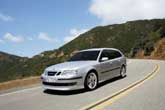
Nuts and Bolts
Nuts and Bolts Buy the standard 2006 Saab 9-3 SportCombi and you get a 210-horsepower turbocharged four-cylinder engine. The 9-3 SportCombi Aero includes a 250-horsepower turbocharged V6. For fuel economy, the less powerful engine is best, scoring 22/31 city/highway according to the EPA. Under the hood of the standard 2006 Saab 9-3 SportCombi is the company’s tried-and-true turbocharged 2.0-liter four-cylinder engine making 210 horsepower at 5,500 rpm and 221 lb.-ft. of torque at 2,500 rpm running on premium fuel. The EPA says that this engine gets 22 mpg in the city and 31 mpg on the highway regardless of transmission choice. A five-speed manual is standard with a five-speed Sentronic automatic optional, either driving the SportCombi’s front wheels. Sentronic is Saab’s clutchless manual shifting feature. All-wheel drive is not available on the 9-3 SportCombi. Twin-five-spoke 16-inch wheels come standard on the base trim, equipped with 215/55 tires. The Aero’s turbocharged 2.8-liter V6 is a blown version of the motor found under the hood of the Cadillac CTS. It requires premium fuel, and makes 250 horsepower at 5,500 rpm and 258 lb.-ft. of torque at a low 2,000 rpm. The low torque peak helps minimize turbo lag, a long-standing characteristic of turbocharged Saab four-cylinder engines, though the standard motor’s generous torque rating and low power peak are also impressive. The EPA says this motor should achieve 18 mpg in the city and 28 mpg on the highway with a manual and 17/28 with the automatic. A six-speed manual is standard, with a six-speed Sentronic automatic and steering wheel shift controls serving as an option. The performance-oriented Aero rides on 235/45 all-season rubber wrapped around handsome five-spoke 17-inch alloy wheels. MacPherson struts with gas-charged shocks and a stabilizer bar suspend the front end of the 2006 Saab 9-3 SportCombi. In back, the four-link independent rear suspension is equipped with the company’s Re-Axs system that provides rear-wheel-steer response for optimum handling and stability. It includes coil springs, gas-charged shocks, and a stabilizer bar. On the Aero model, the suspension is stiffer for improved handling. Four-wheel-disc antilock brakes include electronic brake-force distribution and brake assist, and are ventilated front and rear on Aero models for improved performance. Traction and stability control also come standard. Steering is courtesy of a hydraulic power-assisted rack-and-pinion system.
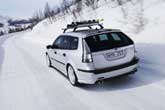
Design
Design Saab says the 2006 9-3 SportCombi’s interior is designed from “the driver outward.” Apparently, in Sweden, that means so many darn buttons sprayed all over the dashboard that operating the 9-3’s myriad controls becomes a major distraction while underway. Saab wanted to preserve its traditional “hockey stick” beltline while creating a useful wagon with maximum utility. The 2006 Saab 9-3 SportCombi’s rakish D-pillars do what they can to create a more traditional fastback profile, but the SportCombi still resembles a station wagon more than it does a classic Saab 900. The high-mounted taillights are LED units with red lenses. Clear-lens taillights – standard throughout the world except the United States – are optional through the dealer rather than standard because, according to California law, taillight lenses must be red. Though handsome in a generic kind of way, the 9-3 SportCombi isn’t much to look at in standard trim – the Aero’s larger, more aggressive wheels and tires go a long way toward giving the SportCombi some much needed attitude. Saab says the 9-3’s interior is designed from “the driver outward,” meaning that everything from control placement to seating position is optimized for the driver. Apparently, in Sweden, that means so many darn buttons sprayed all over the dashboard that operating the 9-3’s myriad controls becomes a major distraction while underway. Making things worse, the buttons all seem to be exactly the same size and shape, with the exact same lettering, so you’ve gotta hunt through the jumble of controls to find the function you want. This could certainly be simplified. Saab designers only need to take a look inside a Lexus to see how it’s done. Interior materials are decent for a luxury car, about what you expect at this price point. The leather in the standard 9-3 SportCombi is a bit rough with an elephant skin texture. The fake wood looks good, but probably works better with the tan interior. Nice touches inside the standard model include silver cabin accents, a woven cloth headliner, and two-tone décor. The sunroof on our test example, a $1,200 option, included one-touch control for opening only, and was rather small. You expect more for a price tag like that. Saab has done a good job of providing storage and cargo areas inside the 9-3 SportCombi. The glovebox is positively huge; illuminated, cooled, and lined with a rubber insert. The center console storage area includes a 12-volt power outlet, and is average in size. Front door bins are nicely sized to accommodate a variety of items. There’s a small tray just forward of the shifter, and each front seat has a webbed pocket on the leading edge. In back, storage pockets are included on both rear seatbacks, and small bins are integrated into the door panels. In the cargo compartment, the floor lifts to split the load area into two separate areas and to reveal underfloor storage cubbies. Saab says that the amount of space behind the rear seats is identical to the slightly larger 2006 9-5 SportCombi. The 9-3 SportCombi’s tailgate is made of aluminum to make it easy to swing closed, the 60/40 split rear seats fold down easily, and there are lots of cargo tie-downs in the lavishly furnished carrying compartment. If you’re hauling passengers and skis, there’s a pass-through slot in the rear seatback for convenience. Note that if you’re at least six-feet-tall, you must watch your head on the corners of the tailgate when it’s raised.
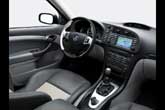
Safety
Safety The 2006 Saab 9-3 SportCombi gets a Gold crashworthiness rating from the Insurance Institute for Highway Safety, the agency’s highest recommendation, thanks to exceptional performance in frontal, side, and rear impacts. Like its main rival in Sweden, Volvo, Saab is known for building safe vehicles, and when it comes to the 9-3, crash testing performed by the Insurance Institute for Highway Safety (IIHS) bears this out. According to the IIHS, the 2006 Saab 9-3 receives a Gold rating for frontal, side, and rear crash protection, the agency’s highest recommendation. That’s not surprising, given the long list of standard safety features designed to help prevent and reduce injury. Every 2006 Saab 9-3 SportCombi comes with adaptive dual front airbags, side-curtain airbags, side-impact airbags for the front seat occupants, and front seat seatbelt pretensioners and load limiters. Saab also includes its second-generation Saab Active Head Restraints (SAHR) system, which has been proven to reduce whiplash injuries in rear-end collisions. Other features designed to help you from getting into an accident in the first place include antilock brakes with electronic brake-force distribution and brake assist, traction control, and stability control. Daytime running lights are also included, and the 9-3 SportCombi’s right exterior mirror offers a parabolic split view to help the driver see her blind spot better. Not only that, but the side mirrors are also heated, helping to improve visibility in wintry climates. Saab also offers its unique Night Panel feature, which allows the driver to dim all interior lights except the speedometer for less distraction at night. Now if we could just get the company to simplify the stereo, climate, and trip computer controls, we’d be all set.
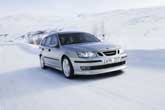
Driving Impressions
Driving ImpressionsHere’s our recipe for the perfect 2006 Saab 9-3 SportCombi. Match the standard high-mileage engine to a six-speed manual transmission, then add the Aero’s wheels, suspension, seats, and interior décor. Price it at $29,995. That’s what we’d want to buy. Sadly, this car does not exist. For this first drive of the 2006 Saab 9-3 SportCombi, we drove the standard model with the 2.0-liter turbocharged four-cylinder engine equipped with the optional five-speed Sentronic automatic transmission, a power sunroof, and roof rails. The test car’s Fusion Blue metallic paint was also extra. The sticker price of this particular car was $30,945, including the $720 destination charge. Unlike the four-cylinder engines found in the Acura TSX and Audi A4, the turbo four in the 2006 Saab 9-3 SportCombi is unrefined. Power delivery is grainy and the Saab loudly grumbles from beyond the firewall. This does not instill a sense of luxury. On a positive note, this motor isn’t peaky like Saab Turbos of old. Thanks to a low torque peak of 2,500 rpm, engine response is strong and linear across a wide rev range, and there’s little torque steer to battle at the helm. Plus, given fuel prices of late, average fuel economy of 24.7 mpg during our test drive is nothing at which to scoff. We’d probably choose the standard five-speed manual, but since most people can’t shift their own gears, the Sentronic automatic will be commonplace. We found this manually-interactive unit slow to downshift for passing power, but when loafing around town it operates unobtrusively and does its job without fanfare. We tried the manual mode, but didn’t find it particularly useful or entertaining. There are few successful substitutes for a clutch pedal. As impressive as the power and fuel economy trade-off is, our favorite things about driving the 2006 Saab 9-3 SportCombi were the steering and brakes. Serving as an example of why electronic steering systems are a pox on humanity, the 9-3’s hydraulic rack-and-pinion steering rack is amazing. Lots of road texture thrums through the wheel rim to the driver’s fingertips, there’s no kickback in rough-edged corners, and it’s easy to add fine degrees of input to perfectly place the car in turns. Mix this with a braking system that offers terrific pedal feel, uncanny balance, and the ability to dial in exact amounts of pressure at the pads, and you’ve got the makings of a wonderful back-road dance partner. Well, maybe in sport-tuned Aero trim, anyway. In the standard 9-3 SportCombi, weight predictably transitions from side to side and the car takes a good set for high-speed sweepers, but there’s significant body roll and the 215/55R16 Pirelli P6 tires fold over and beg for mercy pretty easily. Given how soft the suspension is on the standard model, the ride quality is busy on the highway at times, and there’s too much road noise getting inside for a luxury car. If we’re gonna put up with noise and a busy ride, might as well go with the sportier Aero. Another reason to spend extra for the 9-3 SportCombi Aero is its standard sport seats. Our base model’s front seats were soft, plush, and supportive, but the meager side bolsters did nothing to hold us still on the twisty bits. The 9-3’s seating position is tall with a good view out, and a tilt-and-telescopic steering wheel makes finding a comfortable driving position easy. Our test car would be a terrific choice for long-distance highway drives, especially with that 31-mpg highway fuel economy rating. The 9-3 SportCombi’s rear seat is mounted low but offers good lumbar support. With tall people in front, lanky rear passengers will find their legs flush against the softly padded front seatbacks. Plus, it’s hard to get in and out of the back seat. At least there’s plenty of foot space under the front chairs. Here’s our recipe for the perfect 2006 Saab 9-3 SportCombi. Match the standard high-mileage engine to a six-speed manual transmission, then add the Aero’s wheels, suspension, seats, and interior décor. Price it at $29,995. That’s what we’d want to buy. Sadly, this car does not exist.
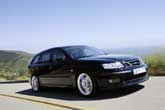
FAQ
FAQ Reasons to consider a 2006 Saab 9-3 SportCombi: Unique, safe, comfortable, fun, value, fun to drive, utilitarian, free maintenance, free driving school, European delivery. Not bad, eh? Q. Why should I consider a 2006 Saab 9-3 SportCombi when so many popular alternatives exist? A. If you’re even looking in the Saab’s direction, you probably want to drive something nobody else has. That’s the first reason. Next, it’s a very safe and comfortable car, with a reasonable price tag, and is genuinely fun to drive while simultaneously offering the utility of an SUV. Dwellers in high-altitude regions will love the turbocharged engines, which are not affected by thin air like other motors. If you get the Aero model, you go to a free two-day driving school if you can pay your way to Georgia. Plus, there’s the cool European Delivery option, making for a memorable vacation. And don’t forget free maintenance for three years or 36,000 miles, whichever comes first. Q. Why should I skip the 2006 Saab 9-3 SportCombi? A. It’s not particularly refined, and if you regularly carry large rear seat passengers, they’ll complain all the time. Folks living where it snows don’t have the option of all-wheel drive with the 9-3 SportCombi. The control panel is an ergonomic nightmare of similarly sized, look-alike buttons, and can be daunting to operate while driving. Both engines require more expensive premium fuel. Finally, you can’t pair the fuel-efficient but still strong base motor with the Aero’s sport-tuned suspension, brakes, and appealing 17-inch wheel-and-tire combo. Q. Is this reviewer biased because he has fond memories of learning to drive in a Saab and his father owns a new SportCombi? A. Let’s see: 10 accolades and 6 criticisms in the first two FAQs. Seems like a good mix to us, and a balanced look at the new 2006 Saab 9-3 SportCombi.
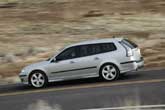
Specifications
Specifications The 2006 Saab 9-3 SportCombi’s main competitors include the Audi A3, Audi A4 Avant, BMW 325iT, Dodge Magnum, Jaguar X-Type Sportwagon, Mazda 6 Sport Wagon, Nissan Murano, Pontiac Torrent, Subaru B9 Tribeca, Subaru Legacy GT, Subaru Outback, Toyota Highlander, Volkswagen Passat Wagon, and Volvo V50. Test Vehicle: 2006 Saab 9-3 SportCombi Price of Test Vehicle: $30,945 (including $720 destination charge) Engine Size and Type: 2.0-liter inline four-cylinder Engine Horsepower: 210 at 5,500 rpm Engine Torque: 221 lb.-ft. at 2,500 rpm Transmission: Five-speed Sentronic automatic Curb Weight, lbs.: 3,175 EPA Fuel Economy (city/highway): 23/34 mpg Observed Fuel Economy: 24.7 mpg Length: 183.2 inches Width: 69.4 inches Wheelbase: 105.3 inches Height: 60.6 inches Legroom (front/rear): 42.3/35.1 inches Headroom (front/rear): 38.9/37 inches Max. Seating Capacity: 5 Max. Cargo Volume: 73 cubic feet Competitors: Audi A3, Audi A4 Avant, BMW 325iT, BMW X3, Chrysler Pacifica, Dodge Magnum, Ford Freestyle, Jaguar X-Type Sportwagon, Lexus RX 330, Mazda 6 Sport Wagon, Mazda Tribute, Mercury Mariner, Mitsubishi Endeavor, Nissan Murano, Pontiac Torrent, Saab 9-2X, Saab 9-5 SportCombi, Subaru B9 Tribeca, Subaru Legacy GT, Subaru Outback, Toyota Highlander, Volkswagen Passat Wagon, Volvo V50, Volvo V70.
Photos courtesy of Saab
